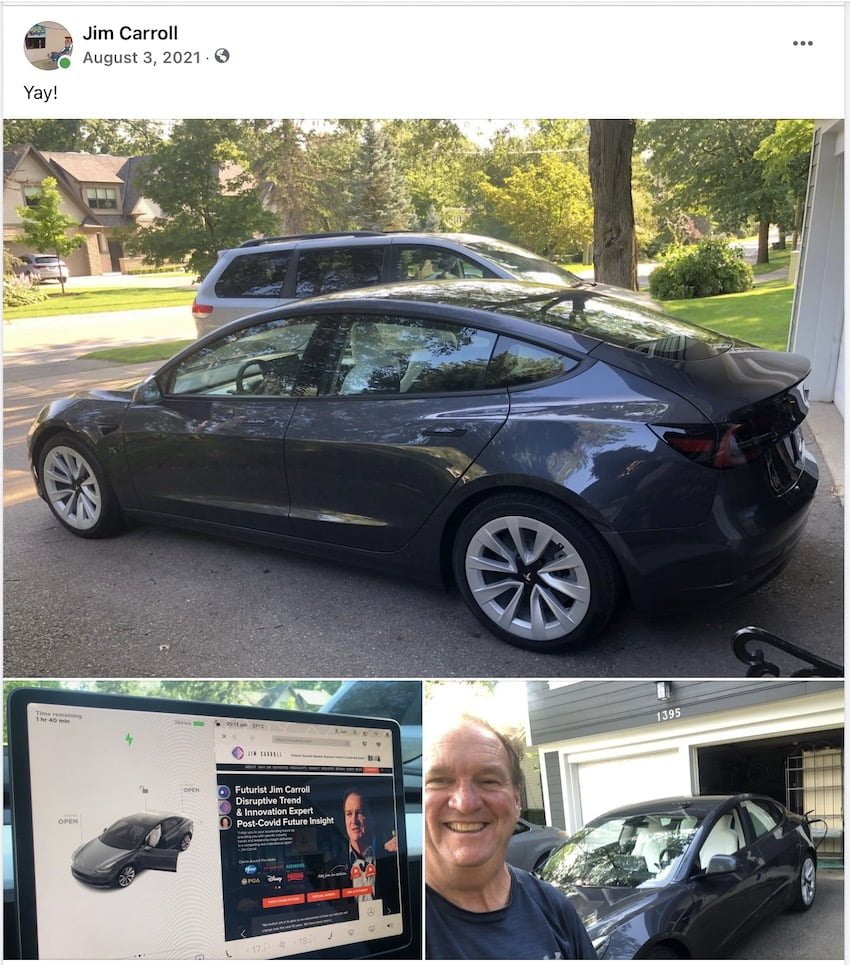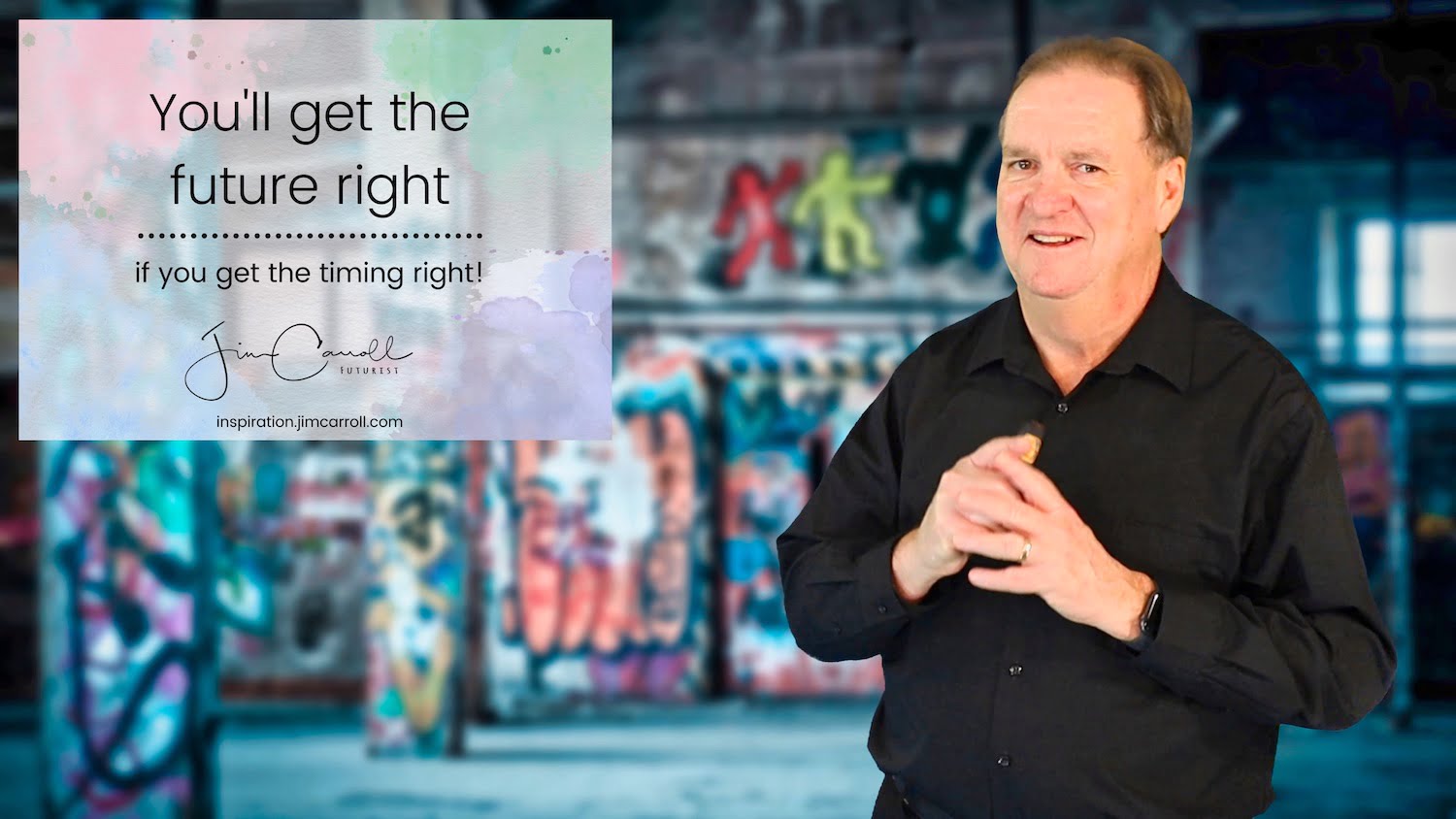One year ago today, it was with much excitement that I received my Tesla Model 3.

It was quite the moment since I’d been talking conceptually on stage about the idea of a Tesla-type vehicle since 2003, when I predicted the business model while at a senior leadership meeting at Mercedes HQ in Stuttgart, Germany. I covered that story when I told it in the context of a “Google Car” – this video from 2006! There are numerous posts on my site as I covered this disruptive trend within the automotive industry at https://tesla.jimcarroll.com and https;//automotive.jimcarroll.com
Some months back, I did a detailed update on my experience with the car, as seen here:
Here’s what I know, one year in:
- Tesla absolutely owns and defines the future of the automotive industry. Essentially, as I often talk about on stage, cars are becoming hyperconnected, rolling technology platforms on wheels with big batteries. Tesla is miles ahead of every other automotive company, bar none. They’ve set the pace, and legacy companies have a huge hill to climb to catch up.
- Tesla defines the future of electric vehicles. The electrical / battery/charging infrastructure is unparalleled and clearly signals that the era of gasoline/diesel is coming to an end. Traditional legacy automotive companies are also struggling to catch up here and have a LONG way to go. EV as defined by Tesla just works, extremely well.
- “Full” self-driving car technology, while promising and an amazing technical leap, won’t really be here for a long time. Tesla has pulled off an extremely sophisticated feat with its current self-driving technology; the mind boggles when you realize what they have managed to accomplish Yet, IMHO, it is nowhere near real FSD, and won’t be for a long time, if ever. In fact, I’ve come to doubt whether we will EVER see real self-driving vehicle technology since to really work, it has to be 99.999999% effective. Right now, the Tesla FSD is more ‘full supervisory driving,’ in that you have to always be engaged, involved, and aware – and there are simply too many ‘disengagements’ where it can’t figure out what to do in a complex scenario. Solving every potential scenario is a tough mountain to climb.
- Buying Tesla FSD at $12,000 is not worth it. Simply put.
Bottom line? I’m thrilled with the car – the design, charging, battery range, computer, and design interface. But my FSD investment? To be honest, I regret the money spent. In fact, If I had to pay money once again to get FSD on a Tesla, I wouldn’t do it – you are essentially paying a big sum of money to get involved in a long, drawn-out beta test that really seems to have no end in sight.
Do I regret my investment in FSD? Many days – but on the other hand, as a futurist who advises companies on how to align to the future, I needed to assess the technology on my own, and so I consider it to be an R&D expense. It’s helped me better understand a key issue of how I interpret the future, and that’s the issue of timing.
Of course, I’ve also learned there are a ton of Tesla fans out there who jump all over this type of statement, with their judgment clouded by their focus on the technological advancement that has been made, rather than recognizing that it won’t be ready for an average human for quite some time.
What have I learned? The entire experience has affirmed for me the importance of the most important keynote and interpretation I am giving to my clients about the future, and that’s the issue of timing, as described here in a keynote I gave for the World Bank in Morocco just before Covid.
I explain this in another video I filmed on the streets of New Orleans.
To a degree, figuring out the timing of the future has now become more important than figuring out the future itself, which is why I dveloped a full keyntoe around the topic quite some time ago, and which has drawn a lot of interest within my cleint base.
Here’s the description.
The speed of change, which has always been overwhelming, is only increasing as technology advances and massive disruption and transformation come into every industry. Jim Carroll’s key mantra – ‘the future belongs to those who are fast’ – has caught the imagination of CEOs and leaders worldwide as they align themselves to the era of acceleration.
We know that legacy is not a guarantee: the most successful businesses of the future won’t be the largest companies with a track record – but the fastest: those who can adapt new innovations, opportunities, and transformations into their business models. But getting the timing right will be the key to their success! That’s why Jim Carroll’s structure for success as found in his “5 Rules to Determine the Arrival of the Future” provides specific, actionable insight on how how to align to the timing of the arrival of the future.
What are those rules?
1. The future happens, but eventually
2. The future is usually slow, and then, instant
3. Technology puts great uncertainty on the accuracy of rules 1 and 2
4. Accelerating science can suddenly make your previous future estimate terribly inaccurate
5. Just when you think you’ve got the future all figured out, kids come along
Using this structure, Jim provides a high-level, fast-paced, content-rich voyage into the future, with perfect guidance on how to align your organization to what comes next, and how to align yourself to the heart of the trends!
That’s why this year, I’ve doubled down on one of my key observations: you’ll get the future right if you get the timing right!





GET IN TOUCH
Jim's Facebook page
You'll find Jim's latest videos on Youtube
Mastodon. What's on Jim's mind? Check his feed!
LinkedIn - reach out to Jim for a professional connection!
Flickr! Get inspired! A massive archive of all of Jim's daily inspirational quotes!
Instagram - the home for Jim's motivational mind!